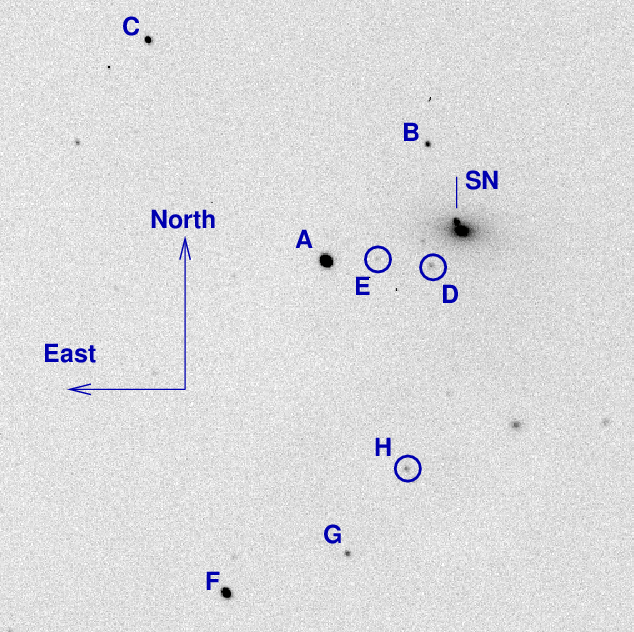
On the night of Jun 22/23, 2016, I observed SN 2016coj in NGC4125. I processed the data in several different methods -- there's a brief discussion near the end of the page.
The main setup was:
Notes from the night
SN 2016coj is a Type Ia supernova in the relatively nearby galaxy NGC4125. It was discovered by the KAIT group some time before maximum light:
NGC 4125 RA = 12:08:05.7 Dec = +65:10:30 (J2000)

The AAVSO sequence team kindly provided photometry for stars near this object. You can see their full photometric sequence on their website. Below, I show only the members of that sequence which fall into my very small field of view -- taken from AAVSO sequence X16266F.
letter B sigB V sigV R sigR I sigI ------------------------------------------------------------------------ B 15.198 0.086 14.133 0.052 13.627 0.116 13.155 0.156 C 13.317 0.093 12.673 0.058 12.316 0.121 11.980 0.161 -------------------------------------------------------------------------
I took sets of 10-20 images in each filter, guiding with success in all filters. I used longer guide exposure times (12 sec) in B and I. I discarded any trailed images, and those with very high background levels from early in the evening. When switching from BVR to I, I re-focused the telescope. That seemed to help I-band, and also a subsequent set of R-band images.
As explained in the notes to Jun 14, 2016, I used the "rotsub" technique to remove the galaxy's light at the position of the SN.
However, this time, I tried three different methods to extract the instrumental magnitudes from the images:
The results were not very different, but I did note that the zero-point calibration was better for methods 2 and 3 than for method 1. The final SN magnitudes generated by these methods varied at most by about 0.04 mag, and in most cases by much less; methods 2 and 3 were nearly identical except for I-band.
In the future, when I re-analyze all the data, I'll probably choose method 2 or 3. But for now, I'll continue using method 1, which has been my default since the start.
Using aperture photometry with a radius of 3 pixels (radius of 4.1 arcsec), I measured the instrumental magnitudes of a number of reference stars and the target. Following the procedures outlined by Kent Honeycutt's article on inhomogeneous ensemble photometry, I used all stars available in each image to define a reference frame, and measured each star against this frame. I used the interim reference magnitudes above plus color terms which I am currently revising -- so please treat these results as preliminary to convert the ensemble instrumental magnitudes to the standard Johnson-Cousins BVRI scale.
Note that in the graph below, I combine data calibrated with UCAC4 photometry (first few weeks) with recent data calibrated with AAVSO photometry. That's inconsistent, and I'll re-compute all magnitudes later.
Results from this evening are:
filter mag mag_uncert Julian Date
SN B = 14.411 +/- 0.071 (ens 0.051 zp 0.050) 2457562.59758
SN V = 13.617 +/- 0.056 (ens 0.020 zp 0.052) 2457562.59023
SN R = 13.618 +/- 0.118 (ens 0.033 zp 0.113) 2457562.60095
SN I = 13.723 +/- 0.144 (ens 0.066 zp 0.129) 2457562.61036
Below is a preliminary light curve, based on RIT Observatory measurements. I also show measurements of SN 2011fe in M101, an ordinary type Ia supernova, shifted arbitrarily.

Last modified 06/22/2016 by MWR.